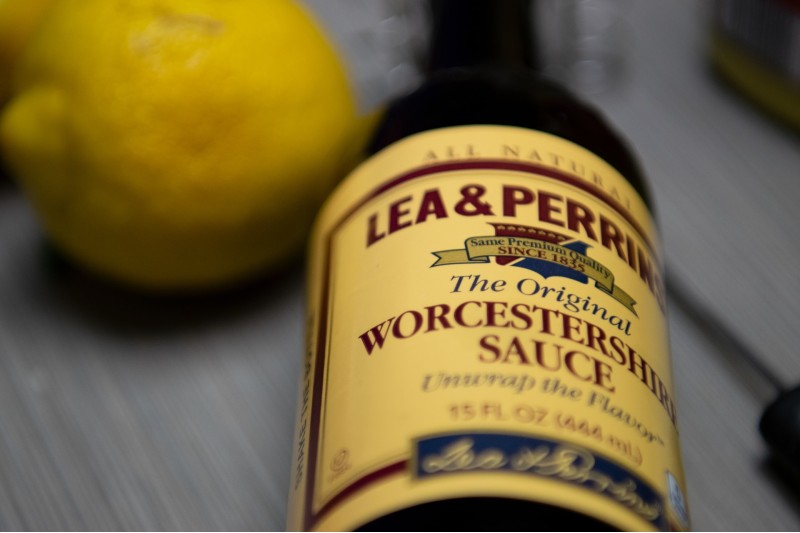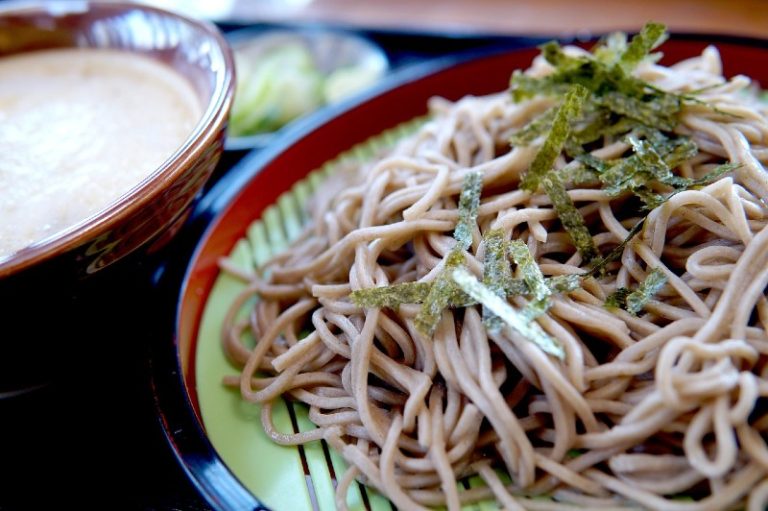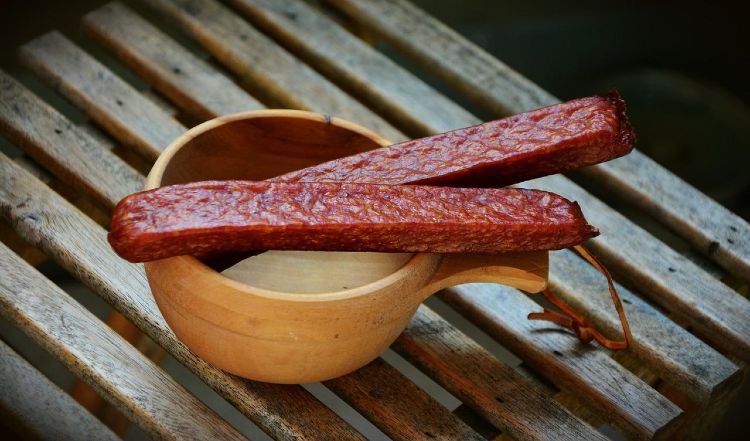Worcestershire Sauce Vs Soy Sauce: Which Sauce Reigns Supreme?
In the vast culinary universe, few condiments have captured the hearts and taste buds of global gourmands quite like soy sauce and Worcestershire sauce.
Soy sauce, with its ancient Asian roots, offers a deep, umami-rich flavor that has become a cornerstone in countless dishes across the East.
On the other hand, Worcestershire sauce, hailing from the town of Worcester in England, boasts a complex blend of tangy, sweet, and slightly spicy flavors, making it a staple in many Western kitchens.
So, why compare these two seemingly disparate sauces? First, both have transcended their regional origins to become internationally beloved. Second, beneath their distinct flavors, there are surprising intersections in terms of culinary uses, umami essence, and even their fermentation processes.
Worcestershire Sauce Vs Soy Sauce Quick Comparison
| Feature | Soy Sauce | Worcestershire Sauce |
|---|---|---|
| Origin | Ancient China, spread across East Asia | Worcester, England with Indian influences |
| Key Ingredients | Soybeans, wheat, salt, water | Anchovies, vinegar, molasses, sugar, salt, seasonings |
| Flavor Profile | Umami, salty | Tangy, sweet, slightly spicy, umami |
| Primary Uses | Traditional Asian dishes, modern fusion cuisines | Classic British meals, cocktails like Bloody Mary |
| Production Process | Fermentation | Aging and blending |
| Nutritional Concerns | Sodium, gluten | Sodium, anchovies (for vegetarians/vegans) |
| Global Popularity | Dominant in East Asia, widespread globally | Strong footprint in Western cuisines, global acceptance |
| Misconceptions | All types are the same, naturally gluten-free | Entirely British, suitable for vegetarians/vegans |
| Special Variations | Light vs. dark, Tamari (often gluten-free) | Vegetarian and vegan versions |
Soy Sauce
Rooted deeply in ancient East Asian traditions, soy sauce represents the harmonious balance of four essential ingredients: soybeans, wheat, salt, and water. Its vast array of regional variations, from the nuanced flavors of Japanese Shoyu to the robustness of Chinese dark soy, underscores its rich history and adaptability.
Beyond its traditional use in Asian dishes, soy sauce’s global outreach is evident in its role as a versatile seasoning in diverse cuisines, from Western to fusion. Its savory, umami-rich profile, while offering potential health benefits, also comes with considerations, especially concerning sodium and gluten content.
Worcestershire Sauce
Originating from the town of Worcester in England, this sauce is a melange of East meets West, combining British techniques with flavors reminiscent of India. Its intricate blend of ingredients, from anchovies and molasses to vinegar and spices, creates a sauce that’s tangy, sweet, and slightly spicy.
Worcestershire sauce’s footprint in Western cuisines is undeniable, but its adaptability has led to its embrace in dishes worldwide. Like soy sauce, it too offers a unique umami touch but with a distinctly Western twist.
Key Ingredients
Soy Sauce
- Soybeans: The primary and vital ingredient, soybeans provide the base flavor and are responsible for the sauce’s signature umami essence.
- Wheat: Often used in many variants, wheat contributes a sweetness and complexity to the sauce.
- Salt: Essential for preservation and flavor, salt also plays a crucial role in the fermentation process.
- Water: Acts as a solvent and helps facilitate the fermentation process.
Worcestershire Sauce
- Anchovies: These small fish are fermented and provide a base umami flavor.
- Vinegar: Adds acidity and tanginess to the sauce.
- Molasses and Sugar: Provide sweetness and a depth of flavor.
- Salt: Enhances flavor and aids in preservation.
- Various Seasonings: Ingredients like tamarind, onion, garlic, and various spices contribute to the sauce’s distinctive taste.
Flavor Profiles
Soy Sauce
The Umami Factor and Its Salty Depth
At the heart of soy sauce is its dominant umami flavor, often referred to as the “fifth taste.” This savory depth arises primarily from the breakdown of soybean proteins during fermentation. Accompanying this umami is a pronounced saltiness, making soy sauce a potent seasoning agent in numerous dishes.
Variations: Light vs. Dark Soy Sauce
- Light Soy Sauce: Typically thinner and lighter in color, light soy sauce has a saltier taste. It is often used for seasoning and in dishes where a darker color isn’t desired.
- Dark Soy Sauce: This is aged for a longer period and often has added molasses or caramel, giving it a deeper color and slightly sweeter, more complex flavor. It’s perfect for braising and adding rich color to dishes.
Other regional variants can also influence the flavor, such as Tamari (a Japanese sauce made mainly from soybeans with little to no wheat) that has a richer and less wheaty flavor.
Worcestershire Sauce
Tangy, Sweet, and Slightly Spicy Nuances
The allure of Worcestershire sauce lies in its multifaceted flavor profile. The tanginess primarily comes from the vinegar base, while the sweetness is derived from molasses and sugar. Additionally, ingredients like chili pepper extract introduce a hint of spice to the sauce, making each drop a journey of taste sensations.
Its Unique Umami Complexity
While soy sauce gets its umami mainly from soybeans, Worcestershire sauce derives this savory depth from a combination of fermented anchovies and tamarind. This intricate blend of ingredients results in an umami that is more complex and layered, with each component adding its unique touch to the overall taste.
Culinary Uses
Soy Sauce
Traditional Asian Dishes
- Stir-Fries: A dash of soy sauce can elevate a simple stir-fry, blending with other ingredients to create a rich, savory coating for vegetables and proteins.
- Marinades: Meats, especially beef and chicken, often get marinated in a soy sauce mixture before grilling or roasting to enhance their flavor.
- Sushi and Sashimi: Soy sauce acts as the perfect dipping companion, complementing the delicate flavors of raw fish.
- Noodle Dishes: From ramen to chow mein, soy sauce is a key component in the broth or seasoning.
- Rice Dishes: Whether it’s fried rice or just a drizzle over steamed rice, soy sauce adds depth and color.
Modern Fusion Cuisines and Its Versatility
- Salad Dressings: Combined with ingredients like sesame oil, vinegar, and honey, soy sauce can create a tantalizing dressing.
- Caramelized Dishes: Soy caramel, made by reducing soy sauce with sugar, offers a delightful glaze for dishes like chicken wings or pork belly.
- Desserts: Believe it or not, soy sauce can add a salty twist to sweets, like in soy sauce ice cream or caramel.
- Cocktails: Some mixologists are introducing soy sauce into their creations, adding a savory touch to beverages.
Worcestershire Sauce
Classic British Meals
- Welsh Rarebit: This savory cheese-on-toast dish often includes a splash of Worcestershire sauce for an added kick.
- Cottage Pie and Shepherd’s Pie: A few dashes of Worcestershire are mixed into the meat filling to deepen its flavor.
- Sunday Roasts: Worcestershire sauce can be included in gravies and marinades to enhance the overall taste.
Global Adaptations
- Bloody Mary: This classic cocktail owes its depth to a generous addition of Worcestershire sauce, which complements the tomato juice and vodka beautifully.
- Marinades: Whether it’s for grilling steaks or BBQ, Worcestershire sauce adds a tangy, savory touch to marinades around the world.
- Caesar Salad Dressing: This globally-loved salad dressing often includes Worcestershire sauce for a tangy twist.
- Chili and Stews: A few dashes can add layers of flavor to hearty dishes, making them even more comforting.
Nutritional Aspects
Soy Sauce
Sodium Content and Potential Health Benefits
- Sodium: One of the major nutritional concerns regarding soy sauce is its high sodium content. Consuming large amounts can contribute to increased blood pressure and other cardiovascular issues. However, when used in moderation as a seasoning agent, its impact can be minimized. Some manufacturers also offer reduced-sodium versions.
- Health Benefits: Despite its sodium content, soy sauce does offer some health benefits. It contains antioxidants and is a source of certain minerals like manganese, magnesium, and phosphorus. Additionally, its fermentation process produces bioactive compounds that may have potential health benefits, such as aiding digestion and improving gut health.
Gluten-free Options and Alternatives
- Gluten Concerns: Traditional soy sauce is made with wheat, making it unsuitable for those with gluten sensitivities or celiac disease.
- Gluten-free Soy Sauce: There are gluten-free versions available where rice or other grains replace the wheat. Tamari, a Japanese variant, is often gluten-free, but one should always check labels to be sure.
- Alternatives: Coconut aminos, made from the fermented sap of coconut palms, can be a soy and gluten-free alternative with a similar savory flavor.
Worcestershire Sauce
Nutritional Breakdown
- Calories: Worcestershire sauce is low in calories, with a typical serving (about a teaspoon) containing around 5 calories.
- Sodium: Like soy sauce, it contains a fair amount of sodium, though the exact amount can vary by brand.
- Sugar: Given its ingredients like molasses and sugar, it does contain some sugars, but the amount is typically minimal per serving.
- Vitamins and Minerals: The sauce has small amounts of vitamin C, vitamin B6, and niacin, along with minerals like calcium and magnesium, though these are not in significant amounts to make a substantial dietary impact.
Vegetarian and Vegan Alternatives
- Anchovies Issue: Traditional Worcestershire sauce contains anchovies, making it unsuitable for vegetarians and vegans.
- Vegetarian/Vegan Versions: Many brands offer vegetarian and vegan versions of the sauce that skip the anchovies but still aim to replicate the signature flavor. These versions often rely more heavily on spices and tamarind to achieve the umami depth.
- Homemade Alternatives: One can also make a homemade version using ingredients like apple cider vinegar, soy sauce, brown sugar, ginger, cloves, and other spices to mimic the traditional flavors without the use of anchovies.
Global Popularity and Market
Soy Sauce
Dominance in East Asia
- Cultural Staple: Soy sauce has been an integral part of East Asian cuisines for centuries. Countries like China, Japan, Korea, and Taiwan have their versions, each with unique flavor profiles and production techniques. It’s used not just as a condiment but as a foundational ingredient in many dishes.
- Production Centers: While China stands as the largest producer and consumer of soy sauce, Japan’s premium and artisanal soy sauces, like Shoyu and Tamari, also have a significant market presence. Korea’s Ganjang and Taiwan’s thick black soy sauce also hold notable regional importance.
Global Outreach
- Western Adoption: With the rise of Asian cuisines in Western countries, soy sauce has become a household staple, used in everything from marinades to modern fusion dishes.
- Brand Expansion: Global brands, like Kikkoman, have made significant inroads into international markets, positioning soy sauce not just as an Asian ingredient but as a universal seasoning.
- Global Production: Beyond East Asia, soy sauce production has taken root in other parts of the world, including North America and Europe, adapting to local tastes and preferences.
Worcestershire Sauce
Footprint in Western Cuisines
- British Origins: Hailing from Worcester, England, Worcestershire sauce became a beloved condiment in British cuisine. Its complex flavor made it an essential ingredient in various dishes, from pies to roasts.
- American Embrace: The U.S. market was quick to adopt Worcestershire sauce, especially for its role in cocktails like the Bloody Mary and its ability to enhance the flavor of grilled meats.
Global Acceptance
- Universal Ingredient: Its unique taste has led chefs and home cooks worldwide to incorporate Worcestershire sauce into various cuisines, from Latin American to Asian dishes.
- Brand Expansion: The original Lea & Perrins brand, along with other brands, have made the sauce available in grocery stores globally. Regional variations and imitations have also sprung up in different countries, reflecting its worldwide acceptance.
- Cultural Adaptations: As the sauce traveled, it was adapted to fit local palates. For instance, in some parts of Asia, a sweeter version is preferred, while in parts of the Americas, a spicier rendition might be favored.
Common Misconceptions
Soy Sauce
- All Soy Sauce is the Same: Contrary to this belief, there are various types of soy sauces depending on the country, region, and method of production. For instance, Japanese Shoyu and Chinese light soy sauce differ in flavor, texture, and ingredients.
- Soy Sauce Contains Only Soy: While soybeans are the primary ingredient, traditional soy sauce also contains wheat, salt, and water. Some varieties, like Tamari, contain little to no wheat.
- It’s Always High in Sodium: Although standard soy sauces can be high in sodium, there are reduced-sodium options available for those looking to cut back on their salt intake.
- Soy Sauce is Naturally Gluten-Free: Given the wheat content in many soy sauces, it’s essential to check labels. Only specific variants, like some Tamari sauces, are genuinely gluten-free.
Worcestershire Sauce
- It’s Entirely a British Creation: While Worcestershire sauce was commercialized and popularized in Britain, its roots trace back to Indian flavors, showcasing a blend of British and Indian culinary traditions.
- It’s Suitable for Vegetarians and Vegans: Traditional Worcestershire sauce contains anchovies, making it unsuitable for strict vegetarians and vegans. However, vegetarian and vegan versions are available.
- Worcestershire Sauce is Just for Meat: While it pairs wonderfully with meats, the sauce’s versatility makes it suitable for a wide range of dishes, including vegetarian meals, cocktails, and more.
- It’s Mainly Vinegar: The tanginess of Worcestershire might lead some to believe it’s predominantly vinegar. In reality, it’s a complex blend of ingredients, including molasses, sugar, salt, spices, and anchovies, that contribute to its unique flavor profile.
Both Sauces
- They Can Replace Each Other: Due to their umami characteristics, some might think they can be used interchangeably. However, they have distinct flavor profiles and components, making them suitable for different dishes and purposes.
- They Have a Long Shelf Life, Regardless of Storage: While both sauces have a good shelf life, it’s essential to store them properly. Over time, soy sauce can lose its intensity, and Worcestershire sauce can develop off-flavors if not stored in a cool, dark place.
FAQs
What is the primary difference between soy sauce and Worcestershire sauce?
Soy sauce is a fermented sauce made primarily from soybeans, wheat, salt, and water. Worcestershire sauce is a complex blend containing ingredients like anchovies, vinegar, molasses, and various seasonings.
Can I use Worcestershire sauce as a substitute for soy sauce (and vice versa)?
While both sauces provide an umami flavor, they have distinct taste profiles. They can sometimes be used as substitutes in a pinch, but the flavors will be different. It’s essential to adjust quantities and consider other ingredients in the recipe.
Is soy sauce gluten-free?
Traditional soy sauce contains wheat, so it’s not gluten-free. However, some versions, like Tamari, are often gluten-free. Always check the label if you have gluten sensitivities.
Can vegetarians and vegans use Worcestershire sauce?
Traditional Worcestershire sauce contains anchovies, making it unsuitable for vegetarians and vegans. However, vegetarian and vegan versions are available in the market.
Why is my soy sauce so salty?
Soy sauce is a fermented condiment where salt plays a crucial role in the fermentation process, giving it a high sodium content. If you’re looking to reduce sodium intake, look for reduced-sodium versions.
How should I store soy sauce and Worcestershire sauce after opening?
Both should be stored in a cool, dark place, preferably the refrigerator, to maintain their flavor and extend shelf life.
Are there regional variations of soy sauce?
Yes, soy sauce has various regional variations, such as Japanese Shoyu, Chinese light and dark soy sauces, and Korean Ganjang, each with its unique flavor and production method.
Is Worcestershire sauce an Asian sauce like soy sauce?
No, while it has some ingredients reminiscent of Asian flavors, Worcestershire sauce has its roots in British cuisine, with some influence from Indian flavors.
Is Worcestershire sauce salty?
Yes, Worcestershire sauce has a salty component to its flavor profile, along with tangy, sweet, and slightly spicy notes. While it’s not as overtly salty as soy sauce, salt is indeed a key ingredient in Worcestershire sauce. When using it in cooking, it’s a good idea to adjust other sources of salt accordingly.
Can I use Soy sauce and Worcestershire sauce in a stir-fry?
Absolutely! Both soy sauce and Worcestershire sauce can be used in a stir-fry to enhance flavors. Soy sauce will provide that classic umami, salty depth that’s synonymous with many Asian dishes. On the other hand, Worcestershire sauce will introduce a tangy, sweet, and slightly spicy undertone to the dish.
Conclusion
Both soy sauce and Worcestershire sauce, though emerging from distinct corners of the world, have carved significant niches for themselves in the global culinary landscape.
In essence, while both sauces share the common thread of amplifying flavors and adding depth to dishes, they each tell a unique story – one of ancient Chinese fermentation traditions, and the other of British culinary innovation influenced by Indian flavors. They stand as testaments to the power of culinary evolution and the global love for flavors that not only season but also narrate histories.




